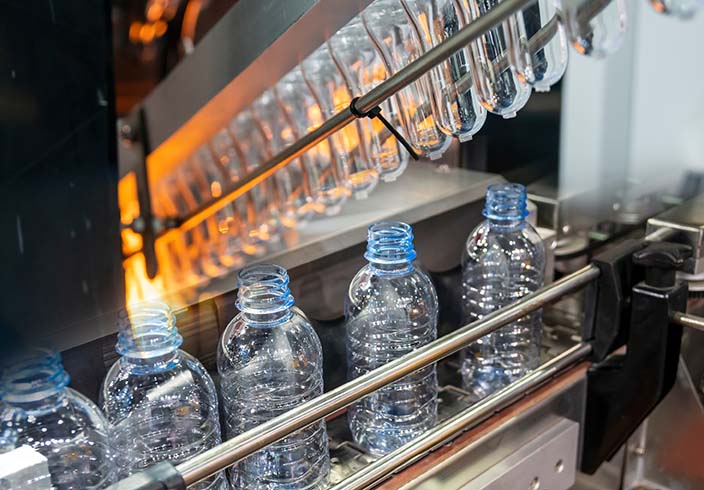The beverage industry has been facing new challenges for years. On the one hand, there are declining sales and increased costs for ingredients, natural gas and electricity, which make it difficult to cover production costs. Added to this are increased demands for sustainability on the part of politicians and consumers, which require a rethink in production. Many beverage producers and breweries are already focusing on innovative solutions such as the digitalisation of production facilities in order to remain profitable in the long term. Energy storage solutions also help to reduce energy requirements and thus lower energy costs.
Current challenges for the beverage industry
Widespread closures in the gastronomy sector during the coronavirus pandemic also caused considerable financial losses in the beverage industry. In addition, many thousands of events were cancelled during the same period, leading to massive losses for breweries in particular. The beverage industry is still feeling the effects today.
Producers are also currently increasingly confronted with the fact that consumers lack the purchasing power to consume large quantities of beverages due to inflation. Falling revenues continue to be offset by high costs for energy and ingredients. The industry needs to rethink and future-proof its processes – above all by making them more energy-efficient – in order to remain competitive despite all the difficulties.
Rising energy prices affect companies
The manufacturing processes in the beverage industry are extremely energy-intensive. Compressed air, which is required for drying, cleaning and sorting, accounts for a large proportion of energy costs. Furthermore, mixers as well as filling systems and palletisers consume a lot of energy.
In the production of beer and mineral water, as well as soft drinks and fruit juices, companies have been relying primarily on gas as an energy source for several years. A development that has led to exploding energy costs, particularly as a result of the Ukraine conflict. The associations of the German beverage industry warned in a joint statement in 2022 that hardly any company in the industry would be able to cover its costs at the current market prices for gas and electricity.
Increased costs for ingredients and preliminary products
Just like beverage producers, their suppliers have also been hit by the rise in energy costs, which is driving up production costs even further and reducing margins. The prices of ingredients such as brewing malt and fruit have tripled in some cases. The glass industry, as an important supplier, is also struggling with the sharp rise in energy prices. According to the Association of German Brewers, the cost of glass bottles rose by 140 per cent between the beginning of 2022 and June 2023. In addition, there are considerable difficulties in the supply chain due to the fact that a large proportion of the glass destined for the European market was previously produced in Ukraine and Russia.
How can beverage manufacturers and breweries produce more sustainably?
In addition to costs for ingredients and preliminary products, companies also have to factor in rising costs for emission allowances in the EU. While they were still less than ten euros per tonne of CO2 when emissions trading was introduced in 2005, the costs now amount to up to 100 euros for the same amount of CO2 emissions. In addition to politicians, consumers are also increasingly demanding products that have been produced sustainably and in a way that protects resources. Greater sustainability in beverage production is no longer just an option, but the basis for long-term economic success and resilience. Despite the industry’s financial difficulties, investment in sustainable and innovative technologies is therefore essential.
Automation and digitalisation
An important step towards an economically viable future lies in the digitalisation and automation of manufacturing processes. Effective monitoring programmes are required, consisting of a network of devices for digital performance monitoring that transmit energy consumption data as well as ingredient requirements. Intelligent sensors in combination with analysis software can be used to optimise processes and save energy. And all this with consistent quality.
This change in the manufacturing process has even more advantages: Downtime for repairs and maintenance can be predicted, so there are no more unexpected stoppages that limit productivity. At the same time, the best possible energy efficiency is achieved because machines are in optimum operating condition.
Examples of successful digitalisation of production facilities
The example of Carlsberg/Holsten shows just how effective the implementation of such solutions can be: thanks to digitalisation, the bottling plants at the new Holsten brewery in Hamburg-Hausbruch, which was built in 2022, will use 25 per cent less water and 34 per cent less energy than the old production facility.
Beverage giant Coca Cola has also already invested in comprehensive smart factory elements and implemented a monitoring system called “LineView”, which records the entire system and displays all production data in real time. In this way, problems and losses on the entire line can be identified immediately and at a glance, and overall plant efficiency can be increased.
Energy storage for sustainable beverage production
Increasing efficiency and energy savings through smart factory solutions are an important component towards sustainability and profitability. To achieve this, the use of innovative energy storage solutions that also facilitate the integration of renewable energies is also an option. The ability to store energy, as offered by ENERGYNEST’s ThermalBattery™, for example, enables companies to switch their energy supply to renewables without the volatility of the latter jeopardising security of supply. Electricity can also be purchased cost-effectively at off-peak times and stored for later use, which enables attractive cost reductions.
Use of the ThermalBattery™ using the example of a brewery
The example of a brewery with a fluctuating daily steam demand of 60 MWh shows just how great the savings potential of the ThermalBattery™ is. In the project developed in collaboration with ENERGYNEST, a storage unit with a capacity of 30 MWth is integrated into the existing plant in combination with an electric steam boiler (10 MWel). The electricity required to operate the steam boiler is primarily drawn from an existing photovoltaic system or from the intraday electricity market at times of low prices and stored in the ThermalBattery™ for later use. In this case, up to 17.1 GWh of natural gas per year and therefore 3.4 tonnes of CO2 per year can be saved. An important step towards more sustainable and competitive beverage production in the long term.
Are you interested in ENERGYNEST, or have any questions regarding our thermal energy storage solutions or our applications for your specific industry?
Don’t hesitate to drop us a line.



